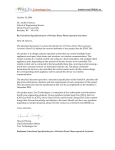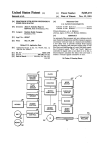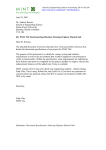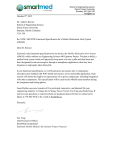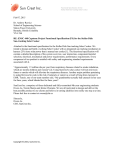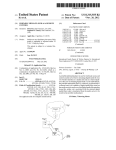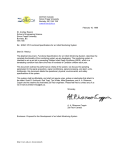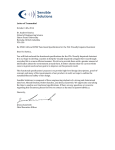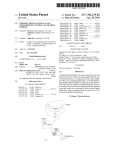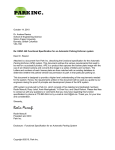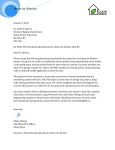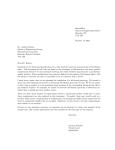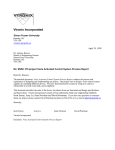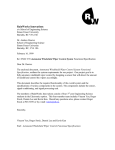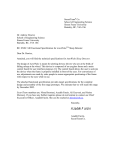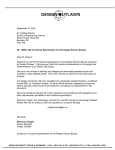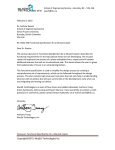Download October 13, 2000 - School of Engineering Science
Transcript
Perfect Pitch Instruments School of Engineering Science Burnaby, BC • V5A 1S6 [email protected] October 13, 2000 Dr. Andrew Rawicz School of Engineering Science Burnaby, British Columbia V5A 1S6 Re: ENSC 340 Functional Specifications for an Automatic Guitar Tuner Dear Dr. Rawicz: The attached document, Functional Specifications for an Automatic Guitar Tuner, outlines the requirements of our project for ENSC 340 (Transducers and Embedded Systems). Our goal is to design and develop an automatic guitar tuner that will mechanically tune a guitar as quickly as possible. This document highlights the desired functionality of the entire system, and the specifications of the various components within the system. The functional components include the sensor input processing unit, the mechanical actuating unit, and the programmable user interface unit. Perfect Pitch Instruments was established by five sharp, creative and talented engineering science students including Gina Millar, Maria Trinh, Aaron Schellenberg, Terrence Yu and Reva Vaze. Should you have any questions or concerns regarding our proposal, please feel free to contact me at (604) 584-8926 or via email. Sincerely, Maria Trinh CEO Perfect Pitch Instruments Enclosure: Functional Specifications for an Automatic Guitar Tuner Perfect Pitch Instruments Functional Specifications for an Automatic Guitar Tuner Project team: Gina Millar Aaron Schellenberg Maria Trinh Reva Vaze Terrence Yu Contact personnel Maria Trinh [email protected] Submitted to: Dr. Andrew Rawicz Steve Whitmore School of Engineering Science Simon Fraser University Date: October 13, 2000 Executive Summary Many students become discouraged or are turned away from learning how to play the guitar at the early stages, when they realize that they cannot grasp a sense of pitch right away. Electronic tuners and pitch pipes exist to help guitar tuning, but they are a hassle, and are sometimes an embarrassment to use when performing in front of others. A guitar player can have an automatic tuning device installed into their existing guitar, but often for a price that is greater than the guitar itself. This document describes the functional specifications of an accessory that will be capable of tuning a guitar quickly and automatically, and would be installed in a guitar at the time of manufacture. It would be suitable for all skill levels ranging from beginner to professional because it could help to ease the learning curve for a novice guitarist or provide a performer on stage with a quick and effective means for tuning their guitar between songs to whatever settings they desire. Better yet, the price of a guitar with this device installed would only cost a fraction more than a guitar without the tuning mechanism. This document introduces the various functional components of this automatic tuning system, outlining the product’s different operating requirements. ã2000 Perfect Pitch Instruments i Table of Contents Executive Summary .............................................................................................................i List of Figures ....................................................................................................................iii List of Tables......................................................................................................................iii Introduction ......................................................................................................................... 1 System Overview ................................................................................................................ 2 Programmable User Interface.............................................................................................. 3 Tuning Range ...................................................................................................................... 5 Self-Training ....................................................................................................................... 5 Sensor input processing....................................................................................................... 6 Signal Acquisition............................................................................................................ 6 Signal Conditioning ......................................................................................................... 6 Signal Output ................................................................................................................... 6 Electrical Requirements ...................................................................................................... 7 Mechanical Requirements ................................................................................................... 7 Physical Requirements ........................................................................................................ 7 Environmental Requirements.............................................................................................. 7 Speed ................................................................................................................................... 7 Safety................................................................................................................................... 7 Standards ............................................................................................................................. 8 Reliability Requirements..................................................................................................... 8 Accuracy .......................................................................................................................... 8 Durability ......................................................................................................................... 8 Potential System Limitations .............................................................................................. 8 Conclusion........................................................................................................................... 9 ã2000 Perfect Pitch Instruments ii List of Figures Figure 1: System Block Diagram ........................................................................................ 2 Figure 2: User-System interaction....................................................................................... 4 Figure 3: Required elements for the Programmable User Interface.................................... 5 Figure 4: Block diagram of signal acquisition .................................................................... 6 Figure 5: Block diagram for signal conditioning ................................................................ 6 List of Tables Table 1: System Physical Requirements ............................................................................. 7 Table 2: System Environmental Requirements................................................................... 7 ã2000 Perfect Pitch Instruments iii Introduction Very few people have “perfect pitch”, the ability to identify a note on the musical scale without having any reference note for comparison. Although the scientific and psychological aspects of perfect pitch are not well known, one thing is certain: whether perfect pitch is an inborn talent or an acquired trait, it need not be an essential or prerequisite for a musician. The goal of our project is to design and develop an automatic electric guitar tuner that would eliminate the hassle involved with tuning a guitar manually. Although tuners exist in the marketplace today, many are handheld requiring the user to pluck a string with one hand, hold the tuner with another hand, and adjust the tension in the strings with another. Clearly too many hands are needed, and the tuning process is unnecessarily time consuming. The few existing automatic guitar tuners cost thousands of dollars, and prove unaffordable for the general public. We envision an automatic guitar tuner that would be installed in a guitar at the time of manufacture. This accessory will be capable of tuning a guitar automatically, and would be suitable for all skill levels ranging from beginner to professional. The tuner can help to ease the learning curve for a novice guitarist or provide a performer on stage with a quick and effective means for tuning their guitar between songs to whatever settings they desire. This document outlines the functional specifications of this product, including the requirements of the sensor input processing unit, the mechanical actuating unit, and the programmable user interface unit. In doing so, this document also resolves Perfect Pitch Instrument’s December 2000 deliverables. ã2000 Perfect Pitch Instruments 1 System Overview The Process Overview is diagrammed in Figure 1. Essentially, the user all but has to pluck the strings on the guitar and the tuning is done automatically. The sounding audio frequencies are conditioned and processed electronically, and are subsequently provided as inputs to a control module. After comparing the pitch of the strings to their desired pitch, the control module adjusts the tension in the strings electro-mechanically, by way of motors, gears, solenoids, etc. The entire process is implemented in a feedback loop, so that the input to the actuators is adjusted dynamically while tracking the pitch of the string. The process completes once the strings are tuned to their desired frequencies. Then it is time to rock! Pluck String Process Audio Rock It! Is String in Tune? Yes =? No Automatically Adjust Tuning Figure 1: System Block Diagram The entire system is composed of three main modules: 1. the programmable user interface unit 2. the sensor input processing unit 3. the mechanical actuating unit Each module is specified in the following pages. ã2000 Perfect Pitch Instruments 2 Programmable User Interface Due to the nature of our project the user interface shall be made as limited as possible so as not to clutter up the body of the guitar. The controls that the user shall have at their disposal are the following: • • • • • 1 On/Off switch - System power button 1 “Tune” button - Toggles between Tune/Not Tune modes 3 Small push buttons – Used to program system settings 1 LCD display, 2 Lines X 16 characters – Setting feedback for the user 1 Bi-colour LED - Indicates tuning status: • Green – string is tuned within specification, • Yellow – String is not within specification and needs to be re-plucked. The user must be able to interface with the automatic tuning system to: 1. Program the chord settings to which the tuner will set each string 2. Tell the system when to start tuning 3. If necessary, abort the tuning process Of course, the user must also pluck the strings to the give the system an input signal. In return, the system itself must let the user know: 1. The system status, whether is it in the tuning process or not, etc. 2. When each string has been successfully tuned 3. If/when an error has occurred and what to do about it. Essentially, once the strings are installed and manually tuned at the head of the guitar within a tolerance of +/- one semitone of the desired pitch, the automatic fine-tuning system will take over (at the base of the guitar) and precisely adjust each string within a very small tolerance to be determined experimentally (see Reliability Requirements). The user shall program the desired setting for each string into the system before entering the “Tune” mode. The default setting shall be the standard 6-string guitar tuning (E A D G B E). Once the desired string settings are programmed into the system, the user shall toggle the mode button to the “Tune” mode. The self-tuning system is now ready to tune the guitar and waits for a plucked string by the user. A threshold detection module shall be used by the system to distinguish user input from residual noise induced in the pickups, perhaps by movements of the guitar. The user shall be required to pluck the string with a moderately firm stroke in order to activate the system, which automatically detects and adjusts the tension in the string being plucked. The system shall not respond if pluralities of strings are plucked simultaneously. The system also assumes that the user is not fretting any of the strings. ã2000 Perfect Pitch Instruments 3 Once the system detects the string being plucked, the LED shall illuminate yellow to indicate that the string is in the process of being tuned. A tuned string shall cause the LED to change from yellow to green. Normally, only one pluck of the string is required of the user to tune a given string. If, however, the string has not been given a sufficient amount of time to tune itself, the LED shall remain yellow, indicating that the user must re-pluck the string. The user shall successively tune each string while monitoring the color of the LED. Once a green light is given for all strings, the user may either toggle out of the “Tune” mode, or simply switch the power button to “OFF”, power down the system while keeping the guitar in tune. While in the “Tune” mode, anytime the system detects that a certain string is being over tensioned, the system shall automatically exit the “Tune” mode and inform the user via the LCD display that an error has occurred and direct the user, if possible, to a corrective action. Possible causes of an over tensioned string are: improper string selection (only standard string gauges are supported), improper tune settings, incorrect initial orientation of the fine-tuning mechanism (the user shall be required to position the fine tuners so that they allow roughly equal adjustment ranges in both directions), or a system malfunction. The user-system interaction and interface are summarized in Figure 2 & Figure 3. Choose chord settings Start system tuning Pluck String Automatic Guitar Tuning System System Status user Success or Error Msg Programmable User Interface Figure 2: User-System interaction ã2000 Perfect Pitch Instruments 4 Push buttons Strings Pick-ups Automatic Guitar Tuning System LCD user LED Programmable User Interface Figure 3: Required elements for the Programmable User Interface Tuning Range The user shall be initially required to adjust each string within a tolerance of +/- one semitone using the tuning pegs at the head of the guitar. At this time, the user shall wish to adjust the initial orientation of the fine-tuning mechanism in order to allow maximum fine-tuning adjustability in both directions. After numerous automatic tunings, several strings may find that their fine tuners are approaching their adjustability limit in one direction. This will be especially evident with the higher strings. At this time, the user shall be required to manually tune the guitar at the head, and re-adjust the orientation of the fine tuners. This is consistent with manual fine-tuning systems commonly available on the market. The total tuning ranges for the fine tuners shall vary from approximately 2 semitones for the high E string, to 4-5 semitones for the low E string. Self-Training A simple user’s manual shall accompany the automatic guitar tuner, outlining the steps to implement the tuning process. With these step-by-step instructions, the user should be able to train themselves. The manual must include: 1. 2. 3. 4. 5. 6. 7. 8. how to string the guitar how to connect the power source to the system how to power up the system how to program the user interface how to initiate the tuning process how to abort the process if necessary how to handle any errors in the system how to turn off the tuning functionality ã2000 Perfect Pitch Instruments 5 Sensor input processing Signal Acquisition Extra equipment to acquire the signal generated by the guitar would be redundant since the pick-ups of an electric guitar are already tailor-made to accomplish the task. As seen in Figure 4, the analog signal produced by the guitar’s pick-ups shall be fed directly to our signal conditioning stage. Input from vibrating guitar strings Output to signal conditioning Guitar Pick-ups Figure 4: Block diagram of signal acquisition Signal Conditioning After being acquired from the guitar pick-ups, the signal is ready for signal conditioning once it passes the amplitude threshold detection circuitry. Signal conditioning is composed of two steps: amplification and filtering. Output to Actuation system Input from signal acquisition Threshold Detector Amplifier Filter Figure 5: Block diagram for signal conditioning Threshold detection allows definite string vibrations to be processed and ignores faint disturbances. Amplification is necessary to amplify the signal to a level that is useful. Filtering is crucial to isolating the vibrations of a single string, cleaning out any external noise pollution in the signal. Signal Output The output of the automatic tuning system is a signal to the actuators to either tighten or loosen the strings, or if necessary, an informative error message to the user as to why no action can be taken in the tuning process. ã2000 Perfect Pitch Instruments 6 Electrical Requirements The system shall operate with a standard 120V AC wall socket power supply. Mechanical Requirements The mechanical assembly entails 6 miniature motors, a motor driver system, a “Floyd Rose Patented” fine-tuning bridge, and a small amount of drive gears and/or belts. The mechanical assembly shall increase the total weight of the guitar by no more than 10%. The mechanical response time shall be made as small as possible. Physical Requirements The automatic guitar tuner as a whole will be embedded into the body of the guitar at the time of manufacture. The system will be discrete, and not interfere with the user. The physical requirements are outlined in Table 1. Table 1: System Physical Requirements Height: Length: Width: Weight: < 4 cm < 10 cm < 10 cm < 0.5 kg Environmental Requirements The system will meet environmental requirements detailed in Table 2. Table 2: System Environmental Requirements Operating Temperature: Heat Dissipation: Humidity: -20C to 60C Minimal (µW range) Over guitar string humidity range Speed The automatic guitar tuning mechanism will tune each string under 10 seconds. Safety The tuning system will detect if a string is overly tightened and at risk of snapping and potentially injuring the user. At this point, an error message will be given to the user and the mechanical actuators will cease to function. ã2000 Perfect Pitch Instruments 7 The entire mechanism, as a finished product, will be encased in a plastic shell to protect the user from the electronic components, also ensuring that the playability of the guitar is not hindered. Standards The tuning system will adhere to IEEE standards, and will be compared to the accuracy of hand-held electronic tuners. Reliability Requirements The guitar tuner shall meet the following reliability requirements: Accuracy The tuner shall adjust the string frequency within a steady-state error to be later determined experimentally. A psycho-acoustic experiment shall be conducted, in which the Just-Noticeable-Difference (JND) is measured for several subjects. The system control parameters shall be adjusted in order to achieve a steady-state error below the measured JND. Durability The device shall be sufficiently robust to withstand daily use, at an average of one tuning per day, for a minimum of 2 years. The device, after being embedded in the guitar body, shall be able to withstand the impact of a 3-meter drop. Potential System Limitations The guitar tuner shall be limited by the following factors: • • • • • The electromechanical system must be small enough to fit inside the guitar body. It also cannot be obtrusive to the musician by extruding too far out of the body. The tuner cannot make a significant weight difference when installed in the guitar. The power required to operate the device should be minimized. Since the electric guitar is a passive device, the tuner will require its own power supply. The strings must be close to their desired frequencies before fine-tuning. Only standard string gauges are supported. ã2000 Perfect Pitch Instruments 8 Test Procedure The following test procedure will verify that the system meets the specifications listed in this document. Both normal and error mode testing will be preformed. During each test the User Interface will also be tested for its required operation. Normal Operation These tests should result in a string frequency within the allowable limits. • • Each string will be set to its standard tuning plus a semitone; test the time required for tuning and accuracy of the resulting string frequency. Repeat for standard tuning minus a semitone. Error Testing Each of the following tests should not affect the function of the tuner, or should result in the appropriate error message being displayed to the user. • • • • Tune a string that is more than a semitone out of tune. One or more strings other than the desired string will be plucked at the same time. Guitar is instructed to tune but no string is plucked. Operation when a bridge fine-tuner reaches its tuning limit. Conclusion This document introduces the various functional components of the automatic guitar tuner and outlines the product’s various operating requirements. Also included are the system’s physical, electrical, and mechanical characteristics. The user interface is described in detail along with any other information that will be of use to the guitar player (i.e., user manual, training etc.). With these functional parameters, we hope that our system will be much appreciated in the guitar world. Rock on! ã2000 Perfect Pitch Instruments 9
















